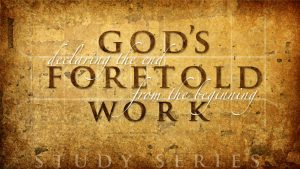Is Isaiah 19 teaching some type of national salvation for egypt? Your question is one that holds great fascination for me. I do see Isa 19 as predicting the national salvation of Egypt, which is to say the surviving remnant that turn in repentance through the judgments that will poured […]
The Cry of the Penitent Remnant
Isaiah 63:10-19 10 But they rebelled, and vexed his holy Spirit: therefore he was turned to be their enemy, and he fought against them. 11 Then he remembered the days of old, Moses, and his people, saying, Where is he that brought them up out of the sea with the […]
The Heart of Apocalyptic Evangelism
[…]
But Doc, here’s the question I want to run by you: What wise use should we who know the prophetic scriptures be making of these current trends that are moving in precisely the direction that prophecy said they would? I’m talking about evangelism, what Art liked to call, “apocalyptic evangelism”. Art compared ‘apocalyptic evangelism’ to the idea of a “delayed reaction bomb”. The seed of the powerful evidence of prophecy is sewn in confidence that it will be soon verified by the deepening crisis that will conform to the pattern that prophecy declares.
We might call it, “pre-evangelism”, particularly in the case of Jews who will not at first receive the Word, but will have later occasion to reflect on what was shown to them from the prophetic scriptures. Of course, the same holds true for anyone, but the church will not come to its appointed fullness independently of its calling to Israel, since the Jew represents the church’s most formidable challenge, and forces believers to do their homework. God knows that when we go to the Jew first, our faith will be tested and deepened. […]
Egypt in Prophecy
[…] That Paul has the same trumpet in view in 1Cor 15:52 is put beyond reasonable question when it is considered that he tells us precisely which time and which resurrection is in view. It is the time of the resurrection of the saints of the Old Testament Isa 25:8; 26:19). It is plainly evident that Paul is deliberately associating the time of the church’s translation with the time of the resurrection of the Old Testament saints. He clearly says that the time of the ‘last trump’ is also the time of the resurrection mentioned in Isa 25:8. This is precisely what Paul is doing when he says, “Then shall be brought to pass the saying which is written …” (1Cor 15:54).
When is “then”? Well, to the chagrin of pre-tribulational teaching, “the saying” is written in Isa 25:8, which is undeniably situated in a post-tribulational context. This is ignored by pre-tribulational teaching. Paul’s statement, “then shall be brought to pass the saying which is written,” is passed over in convenient silence. However, then means then, and Paul’s “then” is manifestly the time of the last trump. […]
The Lord Shall Set His Hand Again The SECOND Time
[…] The status of the present return gives the illusion of a final return only because a second age-long dispersion beginning with the Roman destruction of Jerusalem was not clearly distinguished in the prophets from the much shorter Babylonian captivity. (Note: Those who scorn the concept of a “gap”, or better, ‘hidden age’ between the 69th and 70th weeks of Daniel should consider that if such an interim is not recognized as necessarily implicit in these prophecies, establishing a necessary distinction between a near and partial fulfillment [first-fruits/earnest] and a future fulfillment that is complete and final, then the more serious problem of failed prophecy presents itself, something that liberal critical scholars like to refer to as ‘prophetic dissonance’, since it is certainly no loss to them if prophecy has failed. But quite on the contrary, it is this very phenomenon, in keeping with the divinely designed puzzle of Messiah’s twofold advent, that forms the context and conceptual framework of the mystery revealed in the NT. Hence, a so-called ‘gap’ is by no means without scriptural precedent, but is inherent in the mystery that was divinely hidden for judgment. Indeed, it was necessary for Israel to stumble at the mystery).
Therefore, the first return would see the Jews back in the Land, but still short of the eschatological salvation necessary to endure in the Land, thus looking ahead to an ultimate future tribulation that begins ‘in the Land’. In significant analogy with the first return, the Jews exist in the Land once more as a viable nation with restored covenant institutions (Dan 11:31; 12:1), but the exile continues so long as Israel remains under covenant jeopardy. Thus, the Jews of the modern return are in essentially the same position as those living in the Land after the first return. Though lately returned to the land, they remain subject to the same future tribulation and desolations that ‘the prophets of return’ predicted would persist until the ultimate deliverance of the still future Day of the Lord. The Jews in the Land today are no more ‘home free’ than that first remnant for whom Jacob’s trouble remained a future ‘necessity’ (“for that which is determined shall be done” Dan 11:36). […]
The pride of your power
[…] God is making a point that will reverberate in the Jewish soul for a thousand years. I want to show in what follows that it is very significant to God’s purpose that the Jerusalem that falls under the power of the Antichrist (Rev 11:2; 13:5) has first come under the control of the orthodox, if not entirely, at least to an unprecedented extent. (Compare Ps 83:12; Isa 28:14-15; 63:18; 64:10-11; Dan 8:13; 9:26-27; 11:22, 31, 36-37; 12:11; Mt 24:15, 20; 2Thes 2:4. ).
The picture one gets from these passages is of a Jerusalem that has accommodated the desire of certain orthodox sects of Judaism to rebuild the temple and restore the ancient ritual of animal sacrifice. This suggests sweeping changes in the current policies of the secular government, since under present circumstances; such a scenario is clearly out of the question. Something’s got to give! […]




